Comet ISON vs The Sun – Updates
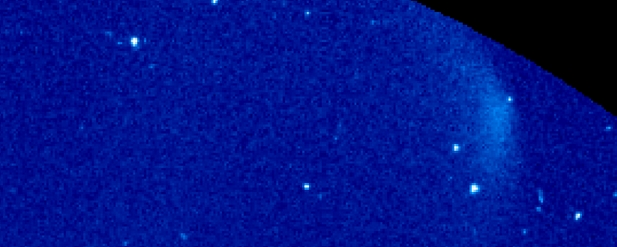
Latest updates:
December 2, 2013
13:45 UTC
Comet ISON's November adventures video by Sun Whisperers

13:43 UTC
Latest CIOC update: In Memoriam: "…Never one to follow convention, ISON lived a dynamic and unpredictable life, alternating between periods of quiet reflection and violent outburst. However, its toughened exterior belied a complex and delicate inner working that only now we are just beginning to understand. In late 2013, Comet ISON demonstrated not only its true beauty but a surprising turn of speed as it reached its career defining moment in the inner solar system. Tragically, on November 28, 2013, ISON's tenacious ambition outweighed its ability, and our shining green candle in the solar wind began to burn out.
Survived by approximately several trillion siblings, Comet ISON leaves behind an unprecedented legacy for astronomers, and the eternal gratitude of an enthralled global audience. In ISON's memory, donations are encouraged to your local astronomy club, observatory or charity that supports STEM and science outreach programs for children."
13:00 UTC
ESA/NASA SOHO's zoomed passage of Comet ISON:
November 30, 2013
ISON is fading and exiting LASCO C3 view.
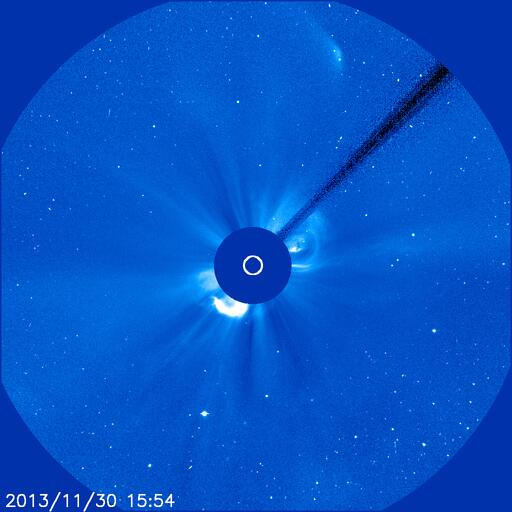

08:18 UTC
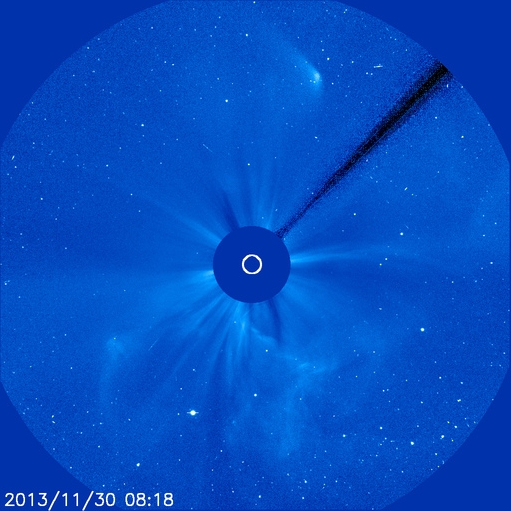

Comet ISON on November 30, 2013 @ 08:18. Image credit: ESA/NASA SOHO
05:30 UTC
Karl Battams (NRL/CIOC) wrote and update on ISON and embeded cool gifs from STEREO: In ISON's Wake, a Trail of Questions
In terms of a timeline, in a few days time I think we'll be able to make a good call on the naked eye visibility of ISON (keep your expectations low, please…). In maybe a week or so I'm guessing we'll fully understand why ISON didn't put on a show in SDO (they might have already figured this out – I don't know – but that's their story to tell, not mine). Give us three or so weeks at least to (hopefully) get Hubble images to say if there's anything left of ISON, and how much, if so. Then expect results from the Comet ISON Observing Campaign to continue appearing for at least, oh, five years? Maybe ten…
One of the questions answered there:
- Will it be naked eye visible? When? How bright?
This is definitely the toughest question but also the most frequent. We still don't know if it will be naked eye but based on its current brightness in the LASCO images – which is around magnitude +5 and fading – it does seem unlikely that there will be much to see in the night sky. I suspect that some of the outstanding astrophotographers around the world will be able to get something, but I doubt it will be as spectacular as before perihelion. I hope I'm wrong though.I'd guess that a few observers will begin picking up ISON in a couple of days but if – and I do mean IF – comet ISON becomes naked eye visible, it won't be until near the end of next week (say, Dec 6 or 7). Please don't get your hopes up, but we all need to keep in mind how ISON keeps surprising us.
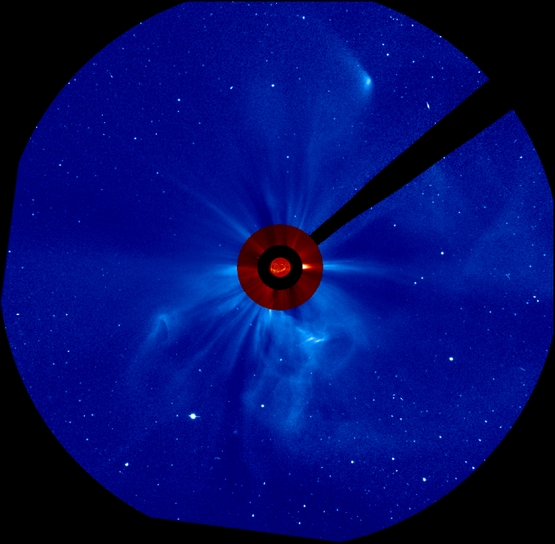

Comet ISON on November 30, 2013 @ 05:35 UTC. Image credit: ESA/NASA/SOHO SDO
01:15 UTC
NASA/SDO scientists are still looking at the data to figure out why ISON was not visible during its closest approach.
Below is the video of STEREO Behind COR2 capturing the close encounter from the approach, perihelion, and finally after a near death experience, the exit. Towards the end of the video you can see what appears to be the tail reforming and changing directions as the flow of the solar wind streams past it.


Animation from SOHO's LASCO C2 and C3 coronographs indicate that ISON really is alive.


Latest images from LASCO C3 and C2
Latest images from LASCO C3 and C2
Since yesterday's 'resurrection,' the comet's overall dust output has clearly increased dramatically as compared with its pre-perihelion situation. John Bortle of Sky&Telescope magazine noted that comet is now experiencing a huge and ongoing dust release in a broad range particle sizes. If ISON continues to exhibit intense dust production and retains sufficient ices to drive activity for a short time, a broad tail of considerable size may quickly develop. It would be impressive mainly from dark-sky observing sites due to rapidly diminishing surface brightness as the object withdraws from the Sun. The comet's 'head' will probably be tiny in comparison with the tail and might even be difficult to define with the unaided eye.
.jpg)
.jpg)
Where to try looking for Comet ISON very low in bright dawn on the morning of December 1st. Mercury, Saturn, and the Moon will be much brighter; start with them to find the spot to examine for the comet with binoculars. (Courtesy of SkyandTelescope.com)
November 29, 2013
20:09 UTC
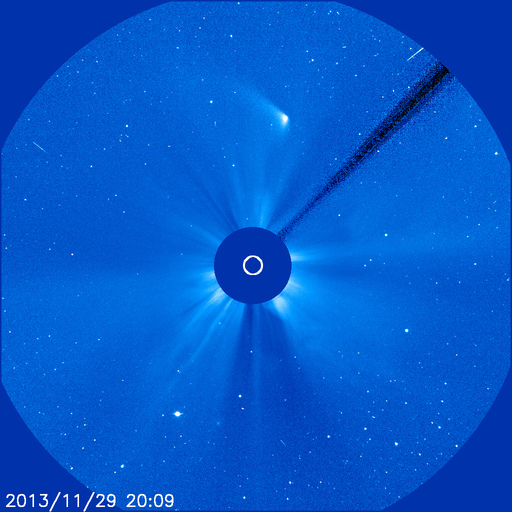

Image credit: ESA/NASA/SOHO
SDO's Dean Pesnell posted update about why we didn't see anything on SDO imagery during ISON's perihelion:
By now I am sure people are aware that something continues to move along the orbit of Comet ISON in the LASCO observations. It is being discussed whether it is debris from Comet ISON or a remnant. In either case we should try to understand why we didn't see that debris or remnant as it went through perihelion yesterday.
When SDO looks for a comet it does not see the dust and ion tails seen in a comet far from the Sun. We see oxygen ions, oxygen atoms with some electrons stripped off, glowing when they are hit by the hot electrons in the corona. The AIA telescopes normally look at iron ions, but the enormous amount of oxygen that comes off a comet allows that element to emit brighter for a while after the comet passes.
The images we showed yesterday were our best guesses for which AIA passbands would show bright emissions from Comet ISON as it flew past the Sun. They are the passbands that showed Comet Lovejoy in December 2011 and the earlier comet in June 2011. All four passbands would show emission from O IV, O V, or O VI, oxygen atoms with 3, 4, or 5 electrons removed. This is a chain, where O V is produced from O IV and then O VI is produced from O V.
We pointed SDO at three locations along the projected orbit. If you compare the predicted orbit with the SOHO images it looks like we had pretty good alignment. I was watching how the comet moved along its predicted orbit as we changed the SDO pointing and the comet moved through the frames we provided. Here is a snapshot of what I was watching, at 1844 UTC yesterday, about the predicted time of perihelion. You can see that the position of Comet ISON is in the upper left part of the square the size of the Sun showing where SDO is pointed. The AIA telescopes have a larger field of view, because they need to see the corona around the Sun. So the comet is well inside the AIA images at this time.
There are some movies posted under "Processed Movies" that show the predicted position of Comet ISON along with the frames taken during the perihelion point. Check out ison_171_location_perihelion.mov or ison_171_location_perihelion.mp4. The color table in these movies has been fixed to bring out dim features in the corona. You can watch the corona loops extending out farther into the corona then we would normally see.
To estimate the brightness of the comet we had to assume a composition of the stuff coming off the comet and the density of the corona it was moving through. Even though the comet is heated by the glow of the Sun to sublimate the material, it is the corona that strips off the electrons to create the oxygen ions.
This means we have a couple of things to check as we try to understand the lack of any visible trail in the SDO images. Did Comet ISON have a strange composition? By strange it would have to have very little oxygen. Many molecules that are found in comets have oxygen atoms in them. Water, carbon dioxide, and most rocks have oxygen in them. Comet ISON appeared normal as it moved through the solar system. It may have been running out of ice as it moved into perihelion, but the dust particles should also have sublimated and contributed oxygen to the corona as they flew past.
Perhaps the corona was not as dense as we assumed. The reactions that cause oxygen ions need fast electrons. Each step in the ion chain takes a little time. If the density of the fast electrons is smaller each step takes a little longer. At the same time the oxygen ions are moving away from the orbit of the comet. As the new oxygen ions get further away from the comet their density goes down and they become more difficult to see. This will require us to go look more carefully at those places in the frames where the comet material has been the longest. Maybe a faint signal can be detected.
We have now seen two sungrazing comets in SDO data. The first disappeared before its perihelion and Comet Lovejoy broke up after perihelion and eventually dissipating. We have also looked for at least two others. One never appeared, and now Comet ISON, which appears to have snuck by perihelion without a trace. We will work to understand what happened as Comet ISON, either as a remnant or debris, flew by the Sun.
We are tied at 2 all for sungrzing comets that we saw and didn't see in AIA data. I hope another sungrazing comet comes by soon to break to tie.
18:18 UTC
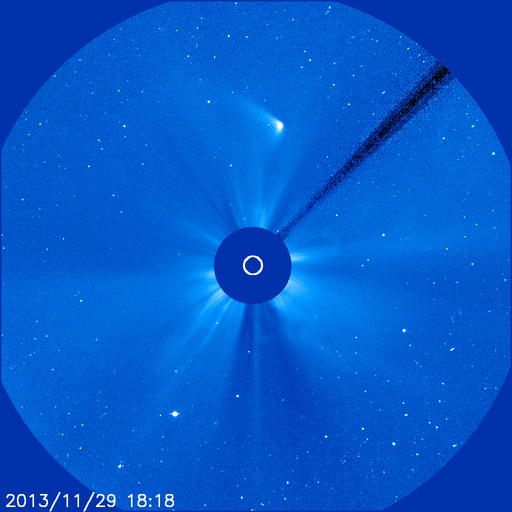

Image credit: ESA/NASA/SOHO
16:25 UTC
One thing we can be certain of is that ISON's nucleus (if there is one) will be significantly smaller now. Lot of mass will have been lost! (via Karl Battams/NRL/CIOC @ Sungrazer Comets)
16:23 UTC
NASA SDO scientists are still looking at the data to figure out why ISON was not visible on SDO imagery. Updates forthcoming.
15:41 UTC
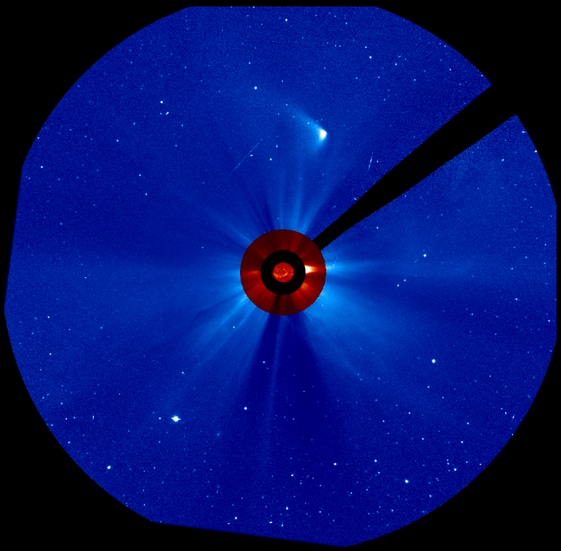

Comet ISON at 15:41 UTC on November 29, 2013. Image credit: NASA SOHO/SDO
12:30 UTC
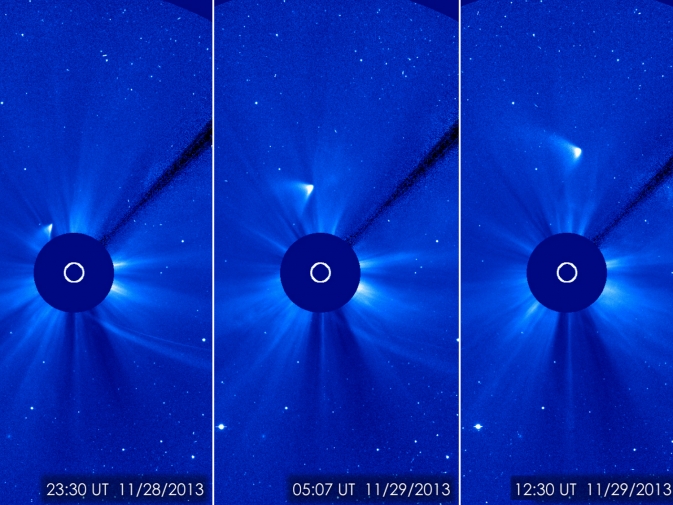

ISON appears as a white smear heading up and away from the sun. ISON was not visible during its closest approach to the sun, so many scientists thought it had disintegrated, but images like this one from the ESA/NASA Solar and Heliospheric Observatory suggest that a small nucleus may be intact. Image credit: ESA/NASA/SOHO/GSFC
- Watch the perihelion LASCO C3 movie here.
08:35 UTC
This is how Comet ISON looks right now:
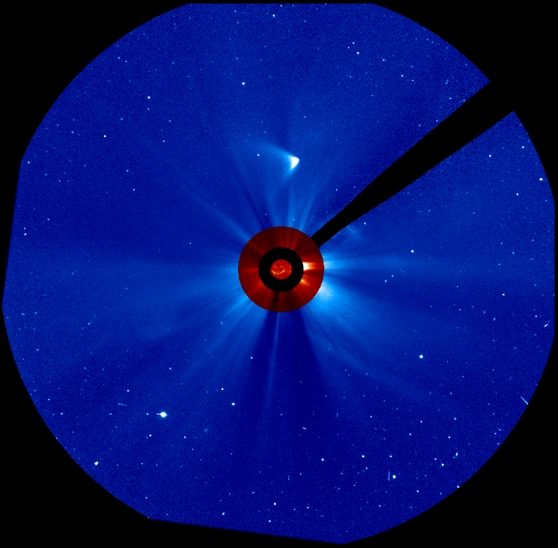

Image credit: NASA/SOHO/SDO on November 29, 2013 @ 08:35 UTC
06:02 UTC
Video of ISON's perihelion:


03:35 UTC
Schrödinger's Comet
By Karl Battams (NRL/CIOC)
I'll just say this upfront right now: whatever you read in the following blog post, please feel free to assume it is completely incorrect and the truth is actually quite contrary to what I'm saying. It has been – and continues to be – one of those days.
So this will be a relatively brief blog post because we're up to our necks in media inquiries and attempting to do real science to figure out the mystery that is comet ISON, and Matthew and I are basically the only ones that have abandoned our loved ones on this US national Holiday and continued to work. Here's what we know so far:
After impressing us yesterday, comet ISON faded dramatically overnight, and left us with a comet with no apparent nucleus in the SOHO/LASCO C2 images. As the comet plunged through the solar atmosphere, and failed to put on a show in the SDO images, we understandably concluded that ISON had succumbed to its passage and died a fiery death. Except it didn't. Well, maybe…
After perihelion, a very faint smudge of dust appeared in the the LASCO C2 images along ISON's orbit. This surprised us a little, but we have seen puffs of dust from Sungrazer tails, so it didn't surprise us enormously and didn't change our diagnosis. We watched and waited for that dust trail to fade away. Except it didn't.
Now, in the latest LASCO C3 images, we are seeing something beginning to gradually brighten up again. One could almost be forgiven for thinking that there's a comet in the images!
Matthew and I are ripping our hair out right now as we know that so many people in the public, the media and in science teams want to know what's happened. We'd love to know that too! Right now, here's our working hypothesis:
As comet ISON plunged towards to the Sun, it began to fall apart, losing not giant fragments but at least a lot of reasonably sized chunks. There's evidence of very large dust in the form of that long thin tail we saw in the LASCO C2 images. Then, as ISON plunged through the corona, it continued to fall apart and vaporize, and lost its coma and tail completely just like Lovejoy did in 2011. (We have our theories as to why it didn't show up in the SDO images but that's not our story to tell – the SDO team will do that.) Then, what emerged from the Sun was a small but perhaps somewhat coherent nucleus, that has resumed emitting dust and gas for at least the time being. In essence, the tail is growing back, as Lovejoy's did.
So while our theory certainly has holes, right now it does appear that a least some small fraction of ISON has remained in one piece and is actively releasing material. We have no idea how big this nucleus is, if there is indeed one. If there is a nucleus, it is still too soon to tell how long it will survive. If it does survive for more than a few days, it is too soon to tell if the comet will be visible in the night sky. If it is visible in the night sky, it is too soon to say how bright it will be…
I think you get the picture, yes?
We have a whole new set of unknowns, and this ridiculous, crazy, dynamic and unpredictable object continues to amaze, astound and confuse us to no end. We ask that you please be patient with us for a couple of days as we analyze the data and try to work out what is happening. We realize that everyone now wants to know if it will be visible in the night sky, and how bright it might be. We really hate speculating right now but if someone were to force us into an answer, we would reluctantly say that at least some faint tail remnant should be visible in the coming week or so. But this is highly speculative so please don't take this too seriously just yet. We will absolutely post updated info here as soon as we're more confident, and I will of course continue blogging when I can in the meantime. Just be patient on this and the truth will unfold in time!
And I just want to end on this note: not long after comet ISON was discovered, it began to raise questions. Throughout this year, as many of you who have followed closely will appreciate, it has continued to confuse and surprise us. For the past few weeks, it has been particularly enigmatic and dynamic, in addition to being visually spectacular. This morning we thought it was dying, and hope was lost as it faded from sight. But like an icy phoenix, it has risen from the solar corona and – for a time at least – shines once more. This has unquestionably been the most extraordinary comet that Matthew and I, and likely many other astronomers, have ever witnessed. The universe is an amazing place and it has just amazed us again. This story isn't over yet, so don't stray too far from your computer for the next couple of days!
01:30 UTC
That rocky/dusty remnant of Comet ISON seems like it's getting a tad brighter. Well, it looks like Comet ISON is ALIVE!
.jpg)
.jpg)
SOHO's LASCO C3 coronograph from 00:07 UTC on November 29, 2013 (Credit: SOHO/ESA/NASA)
.jpg)
.jpg)
November 28, 2013
21:40 UTC
Sungrazer Comets @SungrazerComets
"It is very possible (probable) that we're just seeing debris from comet #ISON falling apart. I just don't see anything like a nucleus."
21:24 UTC
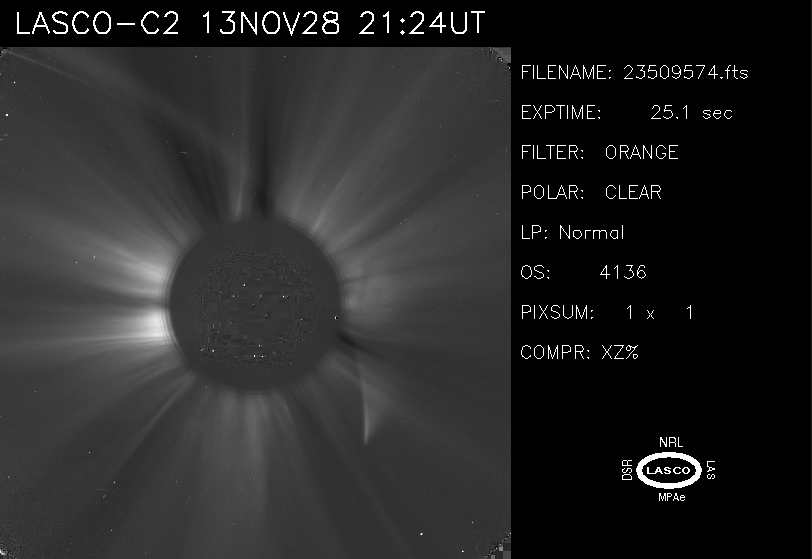

20:57 UTC
Phil Plait @BadAstronomer
"So, I called the total death a bit prematurely. Something has made it around, but we’ll have to see how much stuff and in what condition." (See image from 19:48 UTC)
20:47 UTC
Some reports say that a tiny bit of ISON did survive the clash.
19:48 UTC
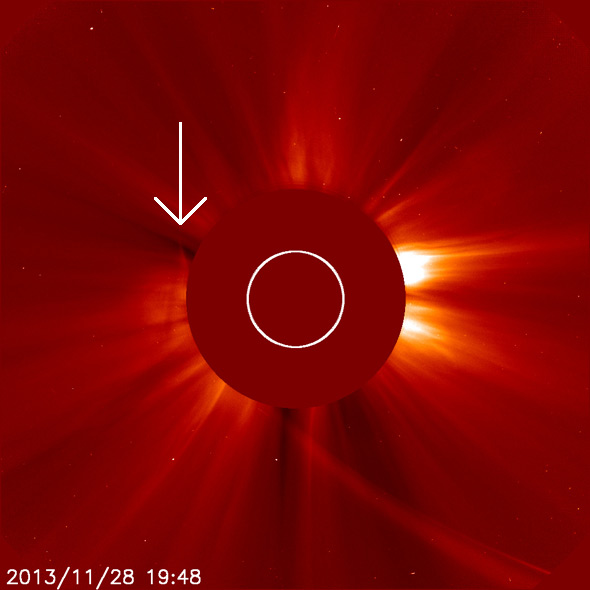

SOHO LASCO C2 view of ISON at 19:48 UTC on Nov. 28. It looks like something made it around the Sun, but it's not ISON as we knew it. Edir: Phil Plait
19:44 UTC
Nothing came up on other side of occulting disc of SOHO's LASCO C2 where ISON should have emerged after perihelion. It is now safe to say that Comet ISON did not survive its close encounter with the Sun.
19:24 UTC
Karl Battams on NASA's hangout: "Let's give it a couple more hours before we pronounce it dead."
19:12 UTC
Click the image to see the video. Image credit: NASA SOHO
19:09 UTC
There is still nothing on SDO images.
18:54 UTC
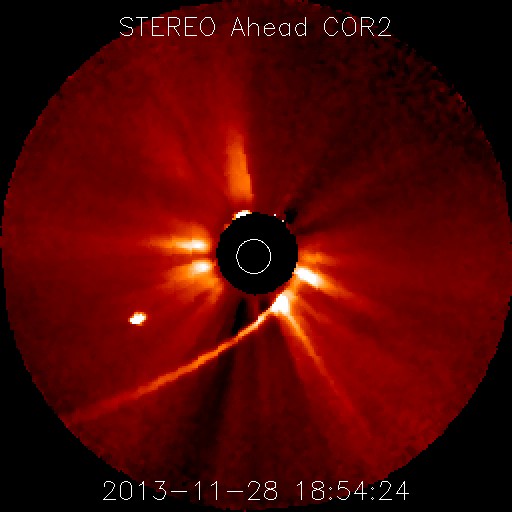



18:36 UTC
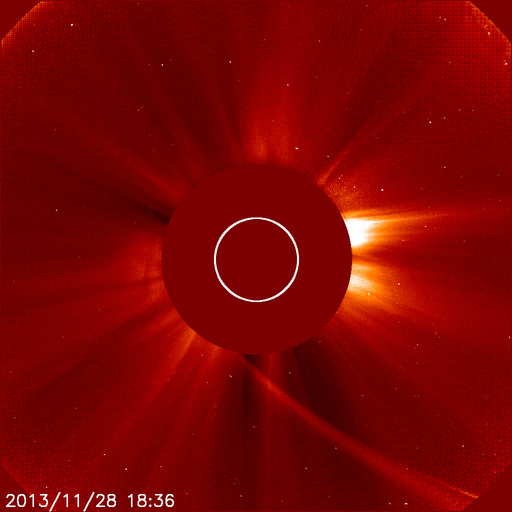

18:20 UTC
Comet ISON has totally evaporate, now it is totally clear:
17:40 UT, STEREO C2: http://www.kommet.cz/datas/users/ison-failed-3_1.png(you can easily compare with pervious image from 16:18 UT
http://www.kommet.cz/datas/users/ison-failed_1.png )Best regards,
Jakub Cerny
- NASA Hangout – Comet ISON Live


17:54 UTC
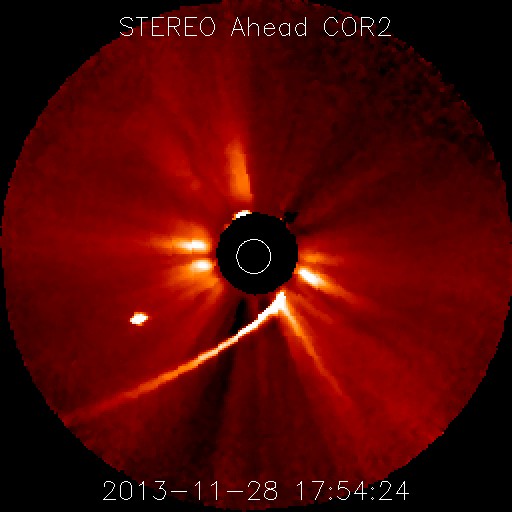

17:48 UTC
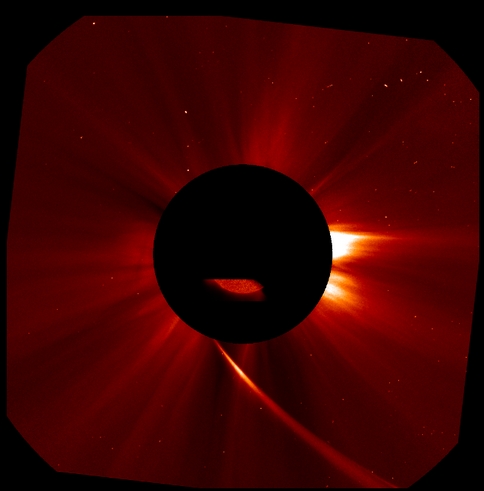

17:44 UTC
SDO images will kick in anytime now…
16:09 UTC
Here is latest STEREO Ahead image:
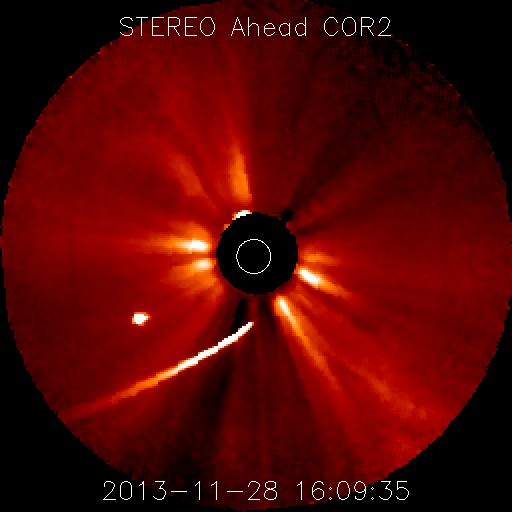

Image credit: Stereo Ahead / COR 2
15:42 UTC
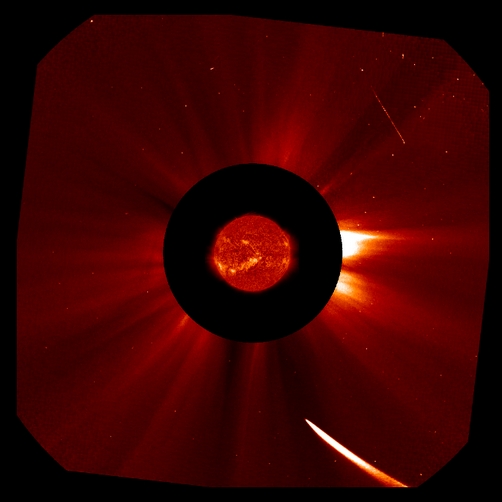

Image taken: 15:42 UTC – Image credit: SOHO LASCO C2/SDO AIA 304
15:25 UTC


Video courtesy: CometISONnews
14:45 UTC – CIOC update (by Karl Battams)
…
There is only a few hours until perihelion, and anything could happen. ISON may have been outbursting in the LASCO field of view, and a rocky nucleus could still exist at the center of all that. If there is still something solid there, and it reaches perihelion, then even if it falls apart at that point, we will still seesomething emerge from the solar atmosphere. And even if the comet does get completely destroyed in the next few hours, I hope that we will get a spectacular show in the SDO images. I also want to note that we are analyzing the SOHO data very carefully and we do see some evidence that maybe ISON's gas production is completely finished but dust production is continuing at a steady rate. Indeed Matthew just said to me, "I have never seen light-curve behavior like this! It's doing completely different things in the different color filters!
He has looked at well over 1,000 sungrazing comets, so when he says a comet is weird… it's weird! So the bottom line is that we have contradictory evidence and we're still trying to interpret it. There is hope for comet ISON!
Regardless of what unfolds today, please remember this: we're watching a truly unique astronomical event for which we have no similar occurrence on record, and we're getting to watch it unfold live on the internet. That's worth restating: this is one of the more extraordinary astronomical events to happen in modern history, and we get to sit in our comfy chairs and watch a giant ball of 4.5 billion year old ice hurtle through the Sun's million-degree outer atmosphere at 0.1% of the speed of light, 93-million miles away from us. Regardless of sizzle, fizzle, or a victorious reemergence, comet ISON's perihelion is a truly spectacular event! (Source)
14:30 UTC
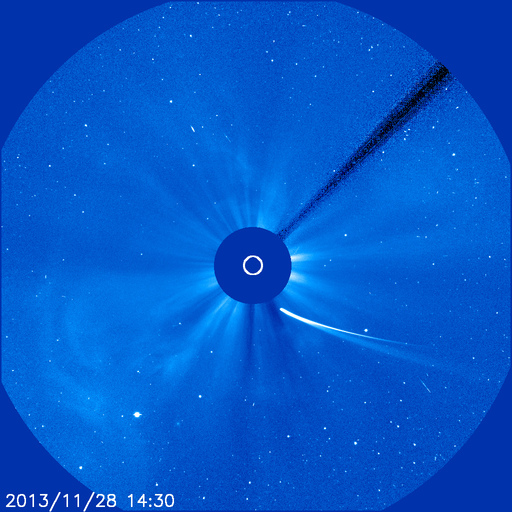

14:24 UTC
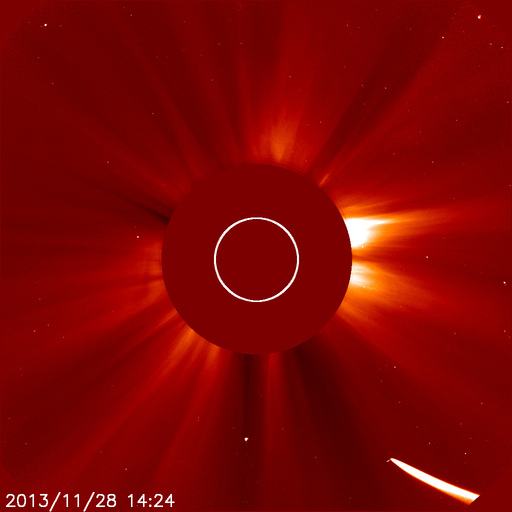

13:19 UTC
Bad news: the very latest images show that #ISON is considerably fainter… via SungrazerComets
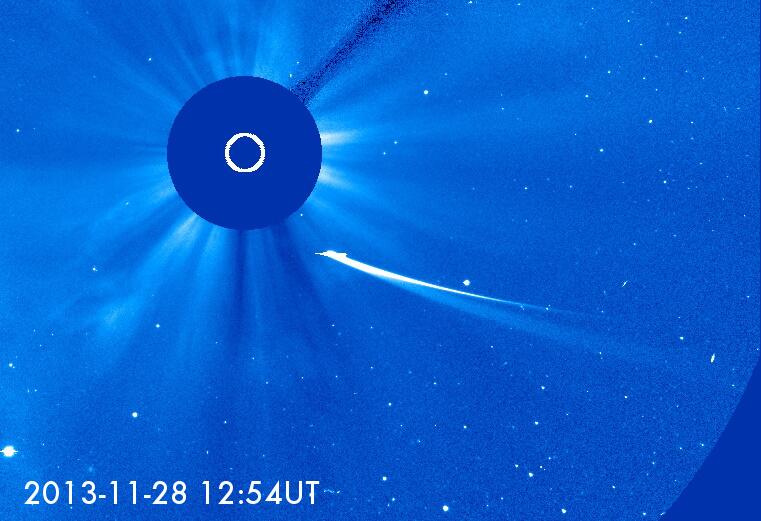

ISON entered LASCO C2 field of view:
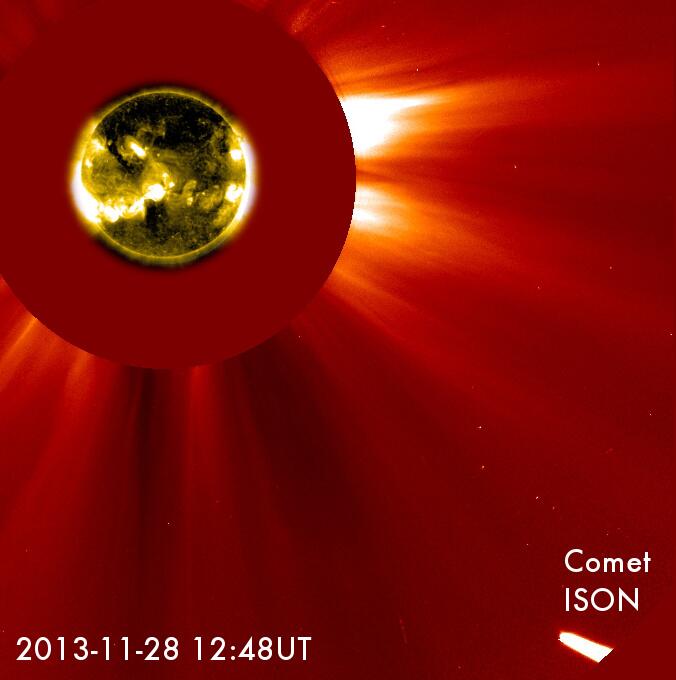

13:10 UTC
SOHO satellite just came back into contact after 3 hr gap. Images are expected soon.
09:18 UTC
Latest SOHO images stopped coming in.
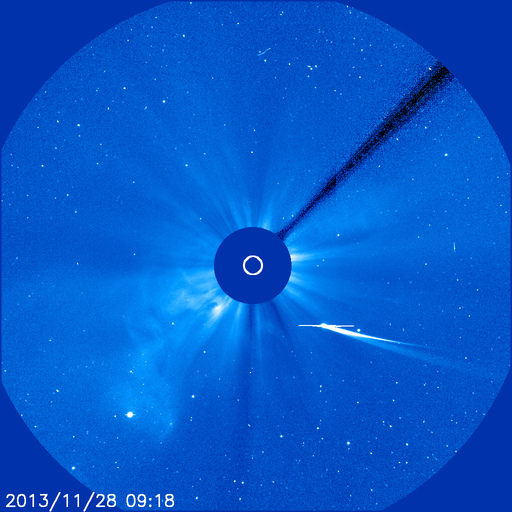

Image credit: NASA SOHO
Comet ISON is having its historic close encounter with the Sun today and it is going live. Yesterday, ISON climbed tremendously in brightness but this can't offer us any evidence at all as to whether it will survive or not.
General consensus is that ISON is behaving like a sungrazer. "It means that ISON is now in a very near-Sun region of the solar system and is experiencing levels of solar radiation that your average comet is never going to have to deal with. Accordingly, its surface is boiling away furiously, releasing tremendous amounts of ice, dust and gas and brightening up enormously." – Karl Battams, CIOC.
If ISON does survive, it will probably become visible to experienced amateur astronomers by December 2 or 3.
***
Live events today
- Links and timetable for real-time images and videos from space-based solar observatories —>>> here.
- From 18:00 – 20:30 UTC – NASA's will host Google+ Hangout "Fire vs. Ison" for live coverage of perihelion and the comet's potential breakup.
- "Comet ISON perihelion party" thread is in progress on Reddit here.
Twitter channels with frequent updates:
- Sungrazer Comets – https://twitter.com/SungrazerComets
- Comet ISON News – https://twitter.com/CometISONnews
***
Featured image: NASA SOHO – LASCO C3 at 19:48 UTC on November 30, 2013.


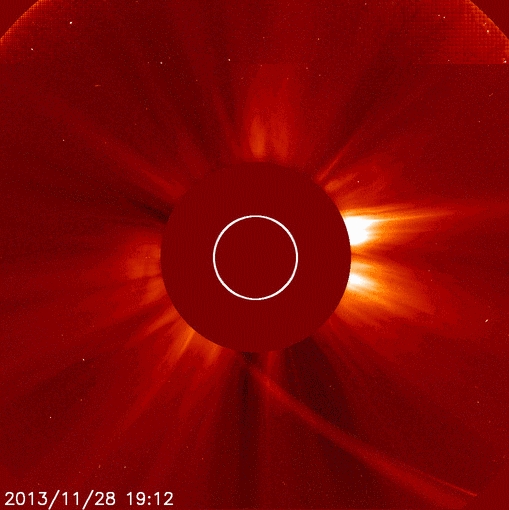
Score one more for the electric universe proponents.
Did anyone see how before it approached the sun it grew wings and resembled a cross. I believe in August 2013 there was another figure like this. Some say it is God. If it has disappeared you could see why.
I watched it live and those people from NASA were jokes. Did the comet really disappear or do they want us to think it really did? Do I trust them? No! How could a comet disappear and nothing left of it? I may not be a rocket scientist but I am not stupid either. God is in control of this and I believe the best is yet to come.